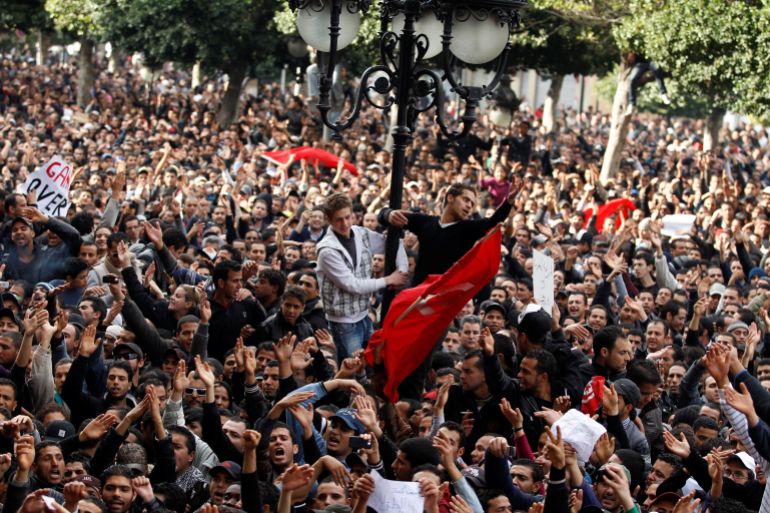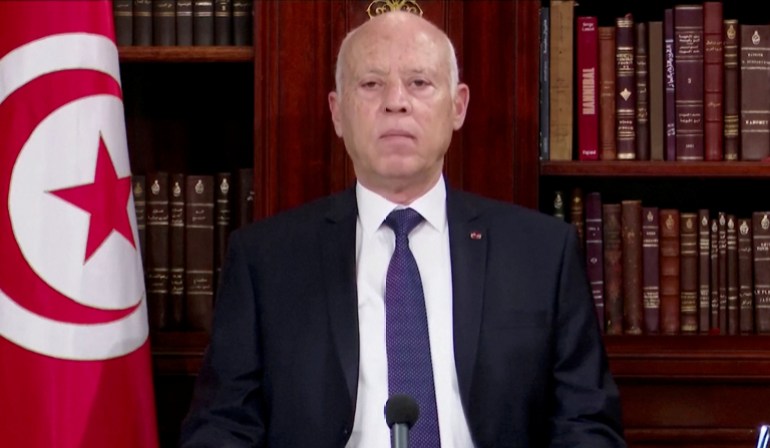The sacking of Tunisia’s parliament is the latest step along a bumpy road since the country’s 2011 revolution.
Tunisian President Kais Saied has sacked the government and frozen the parliament in one of Tunisia’s biggest political crises since the 2011 revolution that introduced democracy.
Here is a timeline of Tunisia’s bumpy decade of democracy and the path to Saied’s decision on Sunday.
December 2010 – Vegetable seller Mohamed Bouazizi sets himself on fire after police confiscated his cart. His death and funeral spark protests over unemployment, corruption and repression.
 Protesters demonstrate against Tunisian President Zine El Abidine Ben Ali in Tunis, January 14, 2011 [Zohra Bensemra/ Reuters]
Protesters demonstrate against Tunisian President Zine El Abidine Ben Ali in Tunis, January 14, 2011 [Zohra Bensemra/ Reuters]January 2011 – Strongman Zine El Abidine Ben Ali flees to Saudi Arabia as Tunisia’s revolution triggers the Arab Spring uprisings across the region.
October 2011 – Moderate Islamist party Ennahdha, banned under Ben Ali, wins most seats and forms a coalition with secular parties to plan a new constitution.
March 2012 – Growing polarisation emerges between Islamists and secularists, particularly over women’s rights, as Ennahdha pledges to keep Islamic law out of the new constitution.
February 2013 – Secular opposition leader Chokri Belaid is assassinated, prompting street protests and the resignation of Prime Minister Hamadi Jebali. Fighters mount attacks on police.
 Tunisians hold a placard of late opposition leader Chokri Belaid during his funeral procession in Tunis, February 8, 2013 [Anis Mili/Reuters]
Tunisians hold a placard of late opposition leader Chokri Belaid during his funeral procession in Tunis, February 8, 2013 [Anis Mili/Reuters]December 2013 – Ennahdha cedes power after mass protests and national dialogue, to be replaced by a technocratic government.
January 2014 – Parliament approves a new constitution guaranteeing personal freedoms and rights for minorities, and splitting power between the president and prime minister.
December 2014 – Beji Caid Essebsi wins Tunisia’s first free presidential election. Ennahdha joins the ruling coalition.
March 2015 – ISIL (ISIS) attacks on the Bardo Museum in Tunis kill 22 people. In June, a gunman kills 38 at a beach resort in Sousse.
The attacks devastate the vital tourism sector and are followed by a suicide bombing in November that kills 12 soldiers.
 Flowers laid on the beach at a resort that was attacked by a gunman in Sousse, Tunisia, June 28, 2015 [Zohra Bensemra/Reuters]
Flowers laid on the beach at a resort that was attacked by a gunman in Sousse, Tunisia, June 28, 2015 [Zohra Bensemra/Reuters]https://youtu.be/eRIA4cKWI3E
March 2016 – The army turns the tide against the ISIL threat by defeating dozens of fighters who rampage into a southern town from across the Libyan border.
December 2017 – The economy approaches crisis point as the trade deficit soars and the currency slides.
October 2019 – Voters show dissatisfaction with the major parties, first electing a deeply fractured Parliament and then political outsider Kais Saied as president.
 Tunisian President Kais Saied addresses the nation, July 25, 2021 [Screengrab from Tunisian President’s Office]
Tunisian President Kais Saied addresses the nation, July 25, 2021 [Screengrab from Tunisian President’s Office] Tunisian men flash the victory sign as tyres burn on blocked roads in Tataouine to protest the government’s failure to keep its promise to provide jobs and investments, February 12, 2021 [Fathi Nasri/ AFP]
Tunisian men flash the victory sign as tyres burn on blocked roads in Tataouine to protest the government’s failure to keep its promise to provide jobs and investments, February 12, 2021 [Fathi Nasri/ AFP]January 2020 – After months of failed attempts to form a government, Elyes Fakhfakh becomes prime minister but is forced out within months over a corruption scandal.
August 2020 – Saied designates Hichem Mechichi as prime minister. He quickly falls out with the president and his fragile government lurches from crisis to crisis as it struggles to deal with the pandemic and the need for urgent reforms.
January 2021 – A decade on from the revolution, new protests engulf Tunisian cities in response to accusations of police violence and the devastation the COVID pandemic wrought on an already weak economy.
July 2021 – Saied dismisses the government, suspends Parliament and says he will rule alongside the new prime minister, citing an emergency section of the constitution. The move is dismissed by Ennahdha and others in Parliament as a coup.
"here" - Google News
July 26, 2021 at 12:53PM
https://ift.tt/3BG5LtP
Tunisia's democracy is in crisis: Timeline of key events - Al Jazeera English
"here" - Google News
https://ift.tt/2z7PfXP
https://ift.tt/2Yv8ZPx
No comments:
Post a Comment